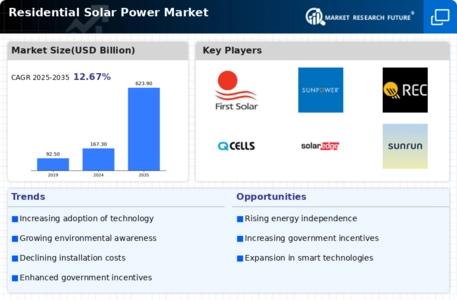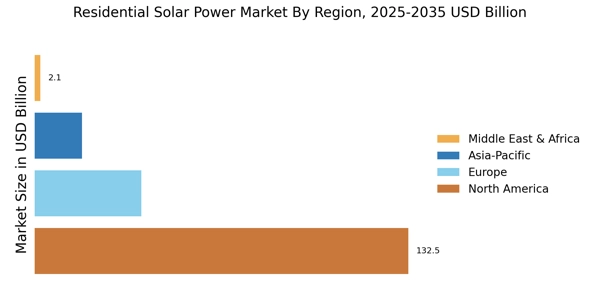Rising Energy Costs
The escalating costs of traditional energy sources are driving homeowners to consider alternative energy solutions, particularly solar power. As energy prices continue to rise, the Residential Solar Power Market appears increasingly appealing. Homeowners are motivated to reduce their reliance on grid electricity, which has seen an average annual increase of 3 to 5% in many regions. This trend suggests that the financial benefits of solar energy, such as lower utility bills and energy independence, are becoming more pronounced. Consequently, the demand for residential solar installations is likely to surge, as consumers seek to mitigate the impact of rising energy costs on their household budgets.
Increased Financing Options
The availability of diverse financing options is facilitating the growth of the Residential Solar Power Market. Homeowners now have access to various financing models, including solar loans, leases, and power purchase agreements (PPAs), which lower the upfront costs associated with solar installations. This flexibility allows consumers to choose financing solutions that best fit their financial situations, making solar energy more accessible. As of 2025, it is estimated that nearly 50% of residential solar installations are financed through these innovative models, indicating a shift in how consumers approach solar investments. This trend is likely to continue, further propelling the expansion of the Residential Solar Power Market.
Government Incentives and Subsidies
The Residential Solar Power Market benefits significantly from various government incentives and subsidies aimed at promoting renewable energy adoption. These financial incentives, which may include tax credits, rebates, and grants, encourage homeowners to invest in solar energy systems. For instance, in many regions, the federal tax credit allows homeowners to deduct a substantial percentage of the cost of solar panel installation from their federal taxes. This financial relief can reduce the payback period for solar investments, making them more attractive. As of 2025, it is estimated that these incentives have contributed to a 30% increase in residential solar installations over the past few years, indicating a robust growth trajectory for the Residential Solar Power Market.
Technological Innovations in Solar Energy
Technological advancements in solar energy systems are playing a crucial role in the expansion of the Residential Solar Power Market. Innovations such as improved photovoltaic cell efficiency, energy storage solutions, and smart grid technologies are making solar installations more effective and user-friendly. For example, the introduction of high-efficiency solar panels has increased energy output, allowing homeowners to generate more electricity from smaller installations. Additionally, advancements in battery storage technology enable homeowners to store excess energy for use during peak demand times. These innovations not only enhance the performance of solar systems but also contribute to a more attractive return on investment, thereby stimulating market growth.
Environmental Awareness and Sustainability
There is a growing awareness of environmental issues and the need for sustainable energy solutions among consumers. The Residential Solar Power Market is experiencing a shift in consumer preferences, with many individuals prioritizing eco-friendly energy sources. This trend is reflected in surveys indicating that over 70% of homeowners are willing to invest in renewable energy technologies to reduce their carbon footprint. As climate change concerns intensify, the demand for solar energy solutions is expected to rise. This heightened environmental consciousness not only drives individual purchasing decisions but also influences policy-making, further supporting the growth of the Residential Solar Power Market.


















Leave a Comment